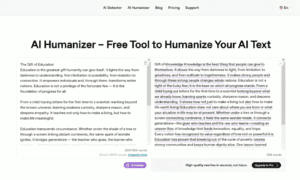A hush settles over the global tech community whenever a new headline drops on the future of artificial intelligence. In the last few months, whispers have escalated into a feverish roar—OpenAI, once valued at a formidable $157 billion, is now eyeing a valuation that could more than double, fueled by SoftBank’s pending multi-billion-dollar infusion.
Meanwhile, China’s rising star DeepSeek rattles assumptions with a powerful AI model produced at a fraction of the cost. Across continents, India also accelerates its push into AI innovation, nurturing a fertile ecosystem of startups and research labs. This collective surge, reminiscent of a modern-day gold rush, has supercomputing centers expanding at breakneck speed and data centers sprouting up like desert oases. Yet beneath the zeal lies a sobering question: who will power it all?
A Clash of Titans: OpenAI vs. DeepSeek and Beyond
The meteoric ascent of OpenAI marks a pivotal moment in the AI race. What began with ChatGPT has blossomed into a vast ecosystem of generative models tackling everything from customer service to scientific research. Now, with talks of a funding round that could value OpenAI at $340 billion, SoftBank stands poised to outstrip Microsoft as its top backer. The partnership highlights a shift in Big Tech alliances, echoing a new era of colossal bets on AI’s role in reshaping global economies.
Yet competition brews in unexpected quarters. DeepSeek’s entry onto the world stage shows that advanced AI can emerge from smaller labs with leaner budgets. Their swift rise unsettles American incumbents, stirring a fresh sense of urgency. CEO Sam Altman of OpenAI has even commended DeepSeek’s accomplishments, noting the model’s remarkable reasoning skills and cost-effectiveness. Add India’s own AI initiatives—a thriving hub where government and private ventures converge on next-gen solutions—and the race becomes undeniably global, cutting across economic, cultural, and geographic lines.
The Infrastructure Squeeze: Data Centers as the New Frontier
At the core of this technological arms race lies infrastructure. AI isn’t just code and algorithms—it demands a physical foundation of servers, chips, and data centers. SoftBank’s multibillion-dollar backing of OpenAI and the U.S. government’s Stargate project, aimed at building a national AI network, signal this shift. Data centers, once handling routine computations, now struggle to support advanced generative models and real-time inference engines. Clusters of GPUs and specialized chips devour electricity nonstop, straining the grid to its limits.
This hunger for power extends beyond American borders. India’s AI surge prompts similar expansions, and China’s DeepSeek demonstrates that hardware limitations can be circumvented through clever engineering. But clever engineering still relies on electrons. The future belongs to those who can marshal both the computational might and the electricity to support it—continuously, sustainably, and without interruption.
Beyond Coal and Gas: The Energy Dilemma in AI’s New Age
The old pillars of industrial revolutions—coal, gas, and even nuclear—now face intense scrutiny. Yet, with AI’s soaring energy demands, can legacy grids bear the load without tipping environmental scales? Traditional renewables—solar, wind, and more—offer part of the solution but grapple with intermittency and land constraints. In resource-scarce or climate-volatile regions, relying solely on these methods risks undermining AI’s promise of seamless reliability.
The scale of new AI infrastructure—particularly the “megaprojects” involving billions of dollars—magnifies the urgency. Complex generative models thrive on continuous data flows, shattering the concept of off-peak hours. Even the greenest solutions like hydrogen or battery backups struggle to deliver unwavering supply if usage rates spike unpredictably. As the stakes rise, the world needs a power source that transcends time-of-day, weather, and location constraints.
Neutrinovoltaics: A Revolution in Constant Power
This is precisely the challenge the Neutrino® Energy Group, led by visionary Holger Thorsten Schubart, aims to solve. Their breakthrough—neutrinovoltaic technology—harnesses the inexhaustible kinetic energy of neutrinos and other non-visible radiation, generating electricity around the clock. Unlike solar panels that rely on sunlight or wind turbines bound by gusts, neutrinovoltaics function ceaselessly, bypassing the pitfalls that hamper traditional renewables. The result is an energy solution that operates invisibly, needs minimal space, and scales elegantly to meet surging AI demands.
By positioning itself at the intersection of disruptive AI and sustainable energy, the Neutrino® Energy Group addresses the essential question plaguing data centers worldwide: how to secure perpetual power without incurring excessive environmental or financial costs. A system that harvests energy not just in daylight or under optimum wind conditions, but every moment of every day, offers a radical alternative. This stands to reshape how supercomputing clusters are powered, granting AI labs, large and small, a foundation as endless as the digital ambitions they pursue.
A Glimpse of Tomorrow: From Megawatts to Milliwatts
The impact extends beyond massive data centers. As edge computing and micro-data nodes redefine connectivity, even small devices require power that never sleeps. Neutrinovoltaics exemplify decentralized energy, enabling microgrids that sustain local operations while reducing reliance on fragile, sprawling grids. Picture AI-driven systems thriving in remote regions, free from diesel’s logistics or solar’s intermittency.
With multinational giants pouring billions into AI, the focus inevitably shifts to sustaining these systems indefinitely. The fusion of perpetual power and boundless data processing fosters breakthroughs unrestrained by energy scarcity. As AI evolves at its natural pace, industries from healthcare to finance gain a transformative edge once confined to science fiction.
Toward an Unstoppable Future
Today’s AI race isn’t just about algorithms, data, or soaring valuations—it’s about energy. As OpenAI secures billion-dollar deals and DeepSeek captures global attention, the true bottleneck isn’t innovation but electricity. Without it, every breakthrough stalls. Neutrino® Energy Group’s neutrinovoltaic technology redefines this equation, offering a decentralized, continuous power source that could quietly fuel AI’s next leap.
The battle for AI dominance no longer hinges on code alone but on forging alliances, advancing hardware, and securing limitless energy. From America’s towering ambitions to China’s cost-efficient strategies and India’s surging ecosystem, the real victor will be the vision that fuses boundless computation with sustainable power—transforming the impossible into reality.





























